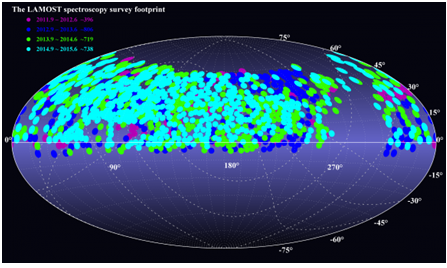The existence of HVS is something that astronomers first theorized in the late 1980s, and only 20 have been identified so far. But thanks to a new study by a team of Chinese astronomers led by LAMOST fellowship Yang Huang, two new hypervelocity stars have been added to that list. These stars, which have been designated as LAMOST-HVS2 and LAMOST-HVS3, travel at speeds of up to 1,000 km/s (620 mi/s) and are thought to have originated in the center of our galaxy.
Astronomers estimates that only 1000 HVS exist within the Milky Way. Given that there are as many as 200 billion stars in our galaxy, that’s just 0.0000005 % of the galactic population.
Containing high-quality spectra of 4.66 million stars and the stellar parameters of an additional 3.17 million, DR3 is currently the largest public spectral set and stellar parameter catalogue in the world. Already, LAMOST data had been used to identify one hypervelocity star, a B1IV/V-type (main sequence blue subgiant/subdwarf) star that was 11 Solar Masses, 13490 times as bright as our Sun, and had an effective temperature of 26,000 K (25,727 °C; 46,340 °F).
HSV2 is 7.3 Solar Masses, is 2399 times as luminous as our Sun, and has an effective temperature of 20,600 K (20,327 °C; 36,620 °F), HSV3 is 3.9 Solar Masses, is 309 times as luminous as the Sun, and has an effective temperature of 14,000 K (24,740 °C; 44,564 °F). The researchers also considered the possible origins of all three HVSs based on their spatial positions and flight times.
In the future, Huang and his colleagues indicate that their study will benefit from additional information that will be provided by the ESA’s Gaia mission, which they claim will shed additional light on how HVS behave and where they come from.

Footprint of the LAMOST pilot survey and the first three years’ general survey. Credit: LAMOST

Address: 20A Datun Road, Chaoyang District, Beijing, China code: 100012
Tel: 010-64888708 E-mail: naoc@nao.cas.cn

